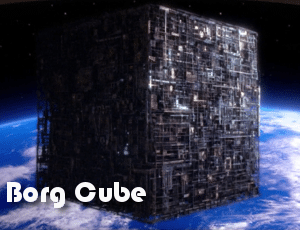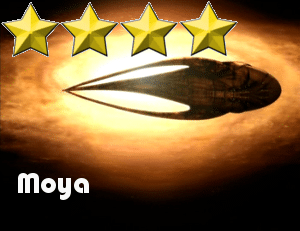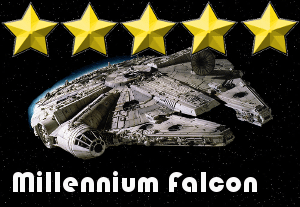
The names make you nostalgic. The sight of one stirs dreams of adventure and excitement. Hearing someone talk about them makes you wish you could be a part of the crew, or better yet, have it to yourself, with your friends as your sidekicks.
Starships: the iconic image of space-based science fiction. A home. A refuge. A way to get from one adventure to another … usually via some calamity smack dab in between. The most beloved share the traits of your first car, a tree fort, and a badass fighter plane.
But what is it about them that makes us love them. Or to put it more plainly, what does a starship need to do to be loved?
Let’s Start With the Unloved

I award you no points, and may God have mercy on your soul. (and no, you may not assimilate God)

We’re grading on a curve. The Empire can thank the Borg they even get 1 star.
Oh, how it’s easy to loathe an evil starship. It’s even fair to say that, despite their obviously inanimate nature, a starship takes on the personality of its commander (and to a lesser extent, its crew). What do we find cold, hateful, and despicable? It should be large, probably larger than it really needs to be. It should be menacing, implacable, and merciless.
One example would be the Executor, Darth Vader’s super star destroyer. I can hear the “but wait a minute” comments now … the Death Star is a space station, not a starship. It can travel, but the Empire called it a station, so I’m ruling it out. Vader’s flagship, however, is fair game. Dark, menacing, and bigger than it has any need to be, this is typical of imperial thinking. You don’t bring a sledgehammer to swat a fly. You bring a turbolaser cannon that will vaporize everything within a mile of the fly. Aiming is for rebels.
Or how about a borg cube? It looks inhuman, without even the basest sense of stylistic sense. You just know that whoever is inside that considers you vermin. Beings with interpersonal skills just don’t construct city-sized assimilating cubes and disperse them across the galaxy.
Start With a Name

It’s a cool little snubfighter. But its hard to fall in love with a nameless ship.
You don’t need your ship’s name to be cool, or make you sound awesome. If you think about most ship names in a vacuum, most don’t really sound that great. But if you name your ship, then do awesome things with it, the name will become awesome. But the name is important. It’s not a matter of what that name is, but the very fact of having it makes the ship a character. It makes it unique. If the ship isn’t a one-of-a-kind already, this is what sets it apart from all its brethren in model year.
Be a Little Different

The Federation flagship is a home … to over a thousand crew. It is grandiose and powerful, manned by the best and the brightest. As to its irreplaceability, see the Enterprise, Enterprise B, and Enterprise C. A mighty vessel that does not beg to be loved.

This ship (if you can even call it a ship) from Spaceballs was more fun that it had any right to be.
Well, we’ve stumbled onto a uniqueness factor in the need for a name. But it helps if the ship is a bit non-standard. After-market customization, one-of-a-kind designs (home-made gets more bonus points than experimental prototype … maybe not in awesomeness, but in lovability certainly), little quirks picked up over the course of its adventures.
How much can you love something that’s just like a thousand other somethings just like it that came on the assembly line? I know, I know … “This is my rifle. There are many like it, but this one is mine…” But how easy is it to get over that feeling that if anything were to happen to the ship, you could just go out and buy a new one? Part of being different and unique is the sense of the irreplaceable.
That Cozy Feeling

A crew of four. Most of the time shown on board is in the common living space. Feels like people live there, not just work there.

It’s a living living space. Sorry, “she.” Moya is more definitively a female ship than most.
This is the Goldilocks Principle at work. A one-man fighter can be a bit lonely. Sure, you might becomes friends with the ship’s computer, but it will be a weird, possibly unhealthy relationship—the spacer’s equivalent of becoming a crazy cat lady. On the other hand, when a ship gets to be too large, you run the risk of it becoming a place, more an ecosystem than a home. How much can you feel like you’re at home when you’re surrounded by a thousand other crew members, many of whom you may not have ever met.
Along with the cozy feeling is the sense of being lived in. Scrubbed and sterile is fine for looking professional. Sleek and polished can look menacing and/or cool. But being rough around the edges makes for a more homey feel. A duffle bag on the floor stuffed with clothes is more cozy than a closet lined with identical, neatly-pressed uniforms.
Be a Little Broken

Its controls were made by copying a TV show. It needs a crewmember to translate to and from the ship’s computer. It has “crushy chompy things” in the internal tunnels. This is not a ship lacking for quirks.

The Falcon makes a good case for being the most beloved ship in all of fiction. It’s a misbehaving bucket of scrap, cobbled together into a formidable smuggling vessel. “The fastest hunk of junk in the galaxy.”
No one likes the Mary Sue character (outside of the fiction, where they have to). The same goes for starships. Do everything, do it well, get all the praise. Sure, you might be the best ship in the fleet, but I’ll take my friendly little bucket any day; she gets the job done just fine. Quirks are nice, but quirks that make life a little more harrowing are always more interesting. You’ll defend your ship’s honor, flaws and all, before you’d trade her in for a shiny new model. The crew learn to adapt around the ship’s limitations, making them a part of normal operations.
Part of the Crew

“I tell you, Zoë, we get a mechanic, get her up and running again, hire a good pilot, maybe a cook – Live like real people. A small crew – They must feel the need to be free. Take jobs as they come. They never have to be under the heel of nobody ever again. No matter how long the arm of the Alliance might get… we’ll just get ourselves a little further.” -Mal
By the time you’re addressing a ship by name, you’ve made it a part of the crew. If you refer to it without “the” before its name, you’ve taken another step in personifying it, not just having it be a thing with a name. Bonus points on this one if the ship is sentient or organic in composition.

MOYA, not Moira. *sigh*
Fixed it. I can’t believe I had it wrong though all those episodes. She needed her name painted on the side or something.
This is a fun consideration of ships that compelled me to share three thoughts.
First, it feels remiss to ignore Anne McCaffery’s http://en.wikipedia.org/wiki/The_Ship_Who_Sang books. Her brain-ship idea set a benchmark not well addressed on screen – save perhaps by; the Deus ex machina tendencies of Dr Who’s TARDIS, and; Lexx –
a 4 season Canadian series about the ship of that name and it’s misfit crew. True, Star Trek: The Motion Picture nods to a more alien version of the concept with V’Ger, but I have yet to see a true human/ship meld that delighted me as much as Anne’s.
Next, imo, a better quote from Serenity is, “You know what the first rule of flying is? … Love. You can learn all the math in the ‘Verse, but you take a boat in the air that you don’t love, she’ll shake you off just as sure as the turning of the worlds. Love keeps her in the air when she oughta fall down, tells you she’s hurtin’ ‘fore she keens. Makes her a home.”
– Malcolm Reynolds
Finally, to explore a personal relationship with ships you grow to love, play the mmorpg, EVE – https://trial.eveonline.com/
😀
Good article. I clicked on it because I’m thinking about working on a new story with a ship in it – but of the seafaring variety not spacefaring variety. Regardless, the same principles apply! 😀
I’ve done both, and I think you’ve got more options to build character into the spacefaring sort, simply because there’s so much left to the imagination. Sea ships have been well established in historical terms, but the future (whether serious or whimsical) is wide open. Spaceships can still be nearly anything.
MisaBuckley Maybe it’s just a coincidence, but since I happen to be a Slavic person, the way this is pronounced sounds to me like a quite universal word in Slavic languages spelled “moja”, which means “mine” in female gender form.